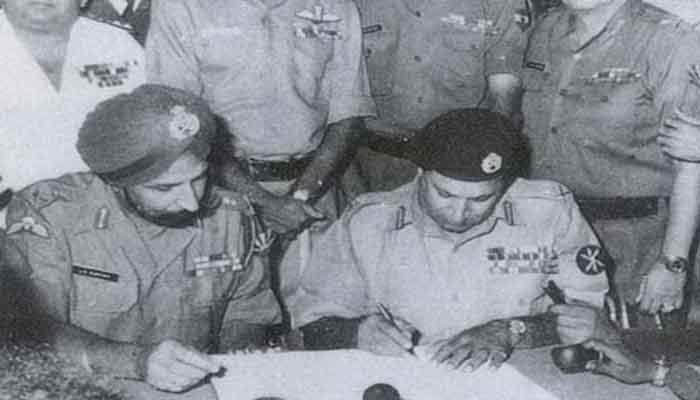
Desk Report
Publish: 16 Dec 2020, 10:44 am

Bangladesh emerged as the free capital of an independent nation as Pakistani military commander Lieutenant General AAK Niazi signed a document conceding defeat at the first such surrender ceremony in public on 16 December 1971.
But it remained largely unclear how hastily the stage was set and who was entrusted with the role until 2012, when the Indian war veteran, Brigadier General Sant Singh, told the BSS reporter that he was the man who organised the ceremony, reports BSS.
Singh, whom the freedom fighters in 1971 fondly called “Brigadier Babaji” because of his attire – typical Sikh turban and beard and affectionate attitude – was talking to this reporter on the sidelines of a ceremony in Dhaka where he along with several other foreigners were awarded with “Friends of Liberation War Honour”.
Singh, who was 94 at the time, recalled that as the Pakistani commander decided to surrender to Dhaka Cantonment in talks with India's East Command Chief of Staff Major General JFR Jacob, he was asked to organise an event at the Racecourse.
“I thought a table and two chairs will be needed for signing the ‘instrument of surrender’ and so I looked around for a suitable table and the chairs at General Niazi’s office,” Singh said.
“I saw the table and grabbed it along with two chairs and rushed to the Racecourse Maidan.”
The non-agenarian general, however, looked at this reporter with a grin and a little surprise gesture, as if all the important things were why he was asked about the "table and chairs."
Singh said he did not have enough time to choose the right corner at the Racecourse to set the simple makeshift stage and ensure safety.
Years later, Liberation war time K Force commander and liberated Bangladesh’s first army chief General Shafiullah, told this correspondent that he was asked to set the stage at Racecourse but as he reached there “I saw the task has been done already”.
“Till today I have no idea who did it,” he said and when this reporter told him the Singh’s story he smiled with amusement.
Singh, a recipient of India’s top gallantry award Maha Vir Chakra (MVC) twice, said he had carried out another crucial task of interrogating Niazi in line with intelligence requirements immediately after the surrendering ceremony.
“We needed to interrogate him for quite a long time on that evening for military requirement or security reasons . . . to know about the location of his troops, their previous plans etc,” said Singh.
Later, he said, Niazi was brought to his residence by the Indian troops “and I went to his home (at cantonment) too”.
“I deployed 30 Indian soldiers to guard the house . . . we were concerned he could flee away as on the previous night several high ranking Pakistani military officers fled the country in helicopters through Burma,” he said.
The citation of Bangladesh’s honour awarded to him pointed that as commander of the Indian military’s FJ Sector in 1971, Singh was fondly called as “Babaji” by the freedom fighters whom he trained for the war.
“After capturing Mymensingh he advanced towards Dhaka via Modhupur and reached Dhaka on 16 December before the surrender of the Pakistani Army. He always led his troops from the front,” read the citation.
“The most memorable moment was the liberation of Dhaka . . . this is the biggest achievement of my career,” he told BSS.
Singh was awarded the second MVC after he captured Mymensingh and Madhupur in Bangladesh while he was leading with just one infantry battalion against two of the enemy.
The citation acknowledged his boldness and decisiveness during the time of liberating Dhaka.
Subscribe Shampratik Deshkal Youtube Channel
Topic : History
© 2024 Shampratik Deshkal All Rights Reserved. Design & Developed By Root Soft Bangladesh